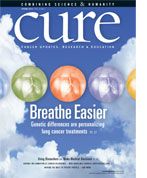Publication
Article
CURE
Research Reveals New Frontiers in Lung Cancer
Author(s):
Focusing on screening and genetic clues, progress in lung cancer shifts forward.
Most days, 32-year-old Lindsay Gomes feels so good that she almost forgets she has stage 4 lung cancer. Tuesdays are a reminder because she receives a weekly infusion of an experimental drug that is helping to keep her cancer at bay. Gomes, and many others like her, are beating the statistical odds thanks to new targeted drugs designed to respond to the genetic characteristics of individual lung tumors.
When Gomes developed a cough five years ago and started having difficulty breathing, no one suspected she might have lung cancer. She was young, had never smoked and had none of the known risk factors for the disease, such as exposure to environmental toxins, such as asbestos or radon gas; nor had she undergone any radiation treatments. By the time she received a diagnosis of adenocarcinoma, the cancer had spread to her lymph nodes and bones.
Lung cancer, which claims the lives of about 160,000 people in the U.S. each year—more than breast, colon and prostate cancers combined—has long been considered a disease of smokers. And, although women who smoke are 13 times more likely to develop lung cancer than nonsmokers and men who smoke are 23 times more likely, the disease doesn’t discriminate. In fact, 10 to 20 percent of new cases are diagnosed in people who have never smoked.
The two main varieties of lung cancer are small cell and non-small cell, the latter of which accounts for 85 to 90 percent of all cases. Non-small cell lung cancer can be further subdivided into adenocarcinomas (the most frequent subtype), squamous cell and large cell carcinomas, as well as additional rarer subtypes. Small cell lung cancer, on the other hand, is the rarer and more aggressive form of the disease, with a five-year survival rate of only 5 to 10 percent.
Surgical removal of the tumor is typically the best chance for curing early-stage, localized lung cancer. But the majority of patients with locally advanced or metastatic lung cancer (stage 3-4) have a relatively bleak prognosis: The median five-year survival rate in this population remains poor, even with chemotherapy.
But the gloom surrounding lung cancer is starting to lift. One reason: Routine screening can detect it earlier in high-risk patients. A recent clinical trial showed that low-dose CT (computed tomography) scanning is more sensitive than standard chest X-rays in detecting earlier stage tumors that are more treatable, resulting in fewer lung cancer-related deaths. Despite the technology’s broad availability, its adoption has been slow—a fact that thoracic oncologist Corey Langer, of the University of Pennsylvania in Philadelphia, attributes in part to the cost of routine screening and the social stigma attached to smoking.
Quitting smoking after a lung cancer diagnosis is also known to improve treatment responses and prolong survival. The majority of people who develop lung cancer have a history of smoking, and many continue to smoke after diagnosis. “Many newly diagnosed patients say, ‘Why should I stop smoking now?’” says Karen McDonnell, an assistant professor of nursing at the University of South Carolina in Columbia, S.C., who develops programs to help patients and their family members stop smoking. “Restricting smoke exposure and stopping smoking are important decisions that patients and their family members can make to improve cancer treatment outcomes and the health of their family. Stopping smoking is difficult to do, but patients and family members who smoke can work together and find expert resources to help them achieve their goal of becoming smoke-free.”
Researchers are also gaining a better appreciation for the complexity of the disease. Increasingly, lung cancers are being classified based on their genetics, and particular genetic mutations—mostly in receptors that control cell growth and division—are now known to be associated with certain types of lung cancer. “The genetics tend to trump the clinical history,” says oncologist Jeffrey Engelman of Massachusetts General Hospital in Boston, noting that these associations pinpoint patients likely to respond to certain targeted drugs. His laboratory is investigating new ways to treat cancer, particularly lung cancer, with this genetic information.
Non-Small Cell Tumors Reveal Targets
Gomes was initially treated with the targeted drug Tarceva (erlotinib), which inhibits a protein called EGFR (epidermal growth factor receptor) that is sometimes mutated in patients with adenocarcinoma. Although treatment guidelines recommend testing the tumor before beginning treatment with Tarceva, Gomes started the drug before her tumor had been tested because the chances of her having an EGFR mutation were good—they occur more frequently in patients with adenocarcinoma who have never smoked and predict a better response to EGFR inhibitors. When Tarceva didn’t work, Gomes’ doctors turned to chemotherapy, but that also had little impact on her cancer.
In the meantime, Gomes was educating herself. She had read about a genetic abnormality, a translocation in the ALK (anaplastic lymphoma kinase) gene that occurs in some patients with non-small cell lung cancer. Studies were showing that tumors with an ALK-translocated mutation were susceptible to a drug called Xalkori (crizotinib), which specifically targets the mutated ALK protein, so Gomes asked her doctor to test her tumor. Although the odds were slim (ALK translocations occur in only 3 to 7 percent of patients with non-small cell lung cancer), her tumor tested positive. She quickly enrolled in a clinical trial for the drug at the University of Colorado Hospital, and within three months, her cancer had melted away.
Langer refers to genetic abnormalities such as those in EGFR and ALK as “actionable,” because there are targeted drugs available to treat patients who have them. EGFR and ALK abnormalities are more common in younger, nonsmokers with adenocarcinoma, but this isn’t a hard-and-fast rule. “Smokers can get the same types of genome alterations that are present in nonsmokers,” says Matthew Meyerson, a cancer researcher at Boston’s Dana-Farber Cancer Institute, whose laboratory focuses on lung cancer and genomics.
A Lingering Risk
Jutta Becker, a 59-year-old former smoker, didn’t expect to receive a diagnosis of stage 4 lung cancer in August 2012. “I thought the diagnosis was probably a mistake,” says Becker, who hadn’t smoked for more than 30 years. Genetic analysis of her tumor revealed an EGFR mutation, meaning she could be treated with Tarceva and spared chemotherapy, which she had been dreading. Becker’s tumor responded well to Tarceva, shrinking almost in half after two months of treatment. And despite coping with many of the side effects of the drug, including rash and diarrhea, she carries on with a relatively normal life. “I still travel and go to parties,” says Becker, “although it’s all slowed down a bit.”
Mutations in other genes that also promote cell growth, such as KRAS and BRAF, tend to crop up more frequently in smokers and former smokers, but so far doctors can’t act on them outside of clinical trials. “We’ve known about the KRAS mutation since the late ’80s, but there are still no FDA-approved agents to target this pathway,” Langer says. But this will hopefully change in the near future. A phase 2 study has shown increased progression-free survival in patients with KRASmutated tumors after treatment with docetaxel and selumetinib, a drug that blocks proteins called MEK that act farther down the KRAS pathway. Tafinlar (dabrafenib), a specific BRAF inhibitor, has demonstrated activity in early phase 2 trials for patients with BRAF mutations, resulting in a fast-track breakthrough therapy designation from the Food and Drug Administration.
Acting on the Non-Actionable
The identification of actionable mutations in patients with non-small cell lung cancer has revolutionized treatment, with these patients surviving, on average, about twice as long as those without such mutations. But it’s important to note that this group is still in the minority. “The pie gets divided up into ever smaller pieces,” says Langer, of the relatively narrow subgroup of patients whose tumors express these mutations. “So, the chances of dining on the pie, of applying a targeted therapy specific to a molecular marker, are less than half.”
For those without actionable mutations—including the majority of patients with small cell and squamous cell lung cancers—the standard of care remains chemotherapy alone or chemotherapy plus radiation for those with locally advanced disease. But the outlook for this group of patients has also improved in recent years. “A significant number of patients with advanced non-small cell lung cancer who don’t have actionable mutations are living two years or more,” Langer says, “and we never used to see that.”
Langer refers to genetic abnormalities such as those in EGFR and ALK as “actionable,” because there are targeted drugs available to treat patients who have them.
This advance is due in part to an improved understanding that certain types of lung cancer respond better than others to particular drug regimens. For example, overall survival is prolonged in patients with adenocarcinoma and large-cell carcinoma treated with Alimta (pemetrexed) plus cisplatin compared with gemcitabine plus cisplatin, whereas the opposite is true for those with squamous cell disease. The targeted drug Avastin (bevacizumab), which blocks the growth of blood vessels to the tumor, improves survival in patients with non-squamous disease only when combined with first-line chemotherapy.
Survival of patients with non-squamous disease can be further prolonged using “maintenance” treatment with Alimta or Tarceva after an initial response to platinum-based chemotherapy. Switching to Alimta after initial chemotherapy might boost overall survival by five months. “That’s one of the most striking improvements ever seen in solid tumor oncology, never mind just lung cancer,” says Langer, who routinely prescribes maintenance therapy for his patients with non-squamous non-small cell lung cancer.
Although the prognosis has substantially improved for these patients, both Meyerson and Langer stress the importance of continuing to search for new mutations that could be targeted by more specific agents in the future.
Responding to Recurrence
After taking Xalkori for about 18 months, Gomes learned her cancer had returned, as it eventually does in the majority of patients who initially respond to the targeted treatment. Drug resistance often results from the tumor’s acquisition of new mutations, either in the originally mutated gene or in different genes that activate new growth-promoting pathways—changes that are often revealed by repeat tumor biopsies.
Fortunately, second-generation ALK and EGFR inhibitors are proving effective against drug-resistant tumors. Gomes entered a clinical trial for the secondgeneration ALK inhibitor ceritinib, which showed activity against Xalkori-resistant tumors in a phase 1 trial, and again her tumor shrank.
A new EGFR inhibitor called Gilotrif (afatinib) was recently approved by the FDA as a first-line treatment against nonsmall cell lung cancer with specific EGFR mutations after it proved to be superior to chemotherapy. Gilotrif might also provide some benefit to patients whose tumors progress while on Tarceva or the related drug Iressa (gefitinib), perhaps because it also blocks one of the most commonly mutated forms of EGFR (called T790M) that confers resistance to Tarceva and Iressa. It is still in the early stages of testing.
Despite the promise of second-generation EGFR inhibitors, Engelman is most excited about third-generation agents, now in early clinical trials. These drugs, including AZD9291 and CO1686, are irreversible inhibitors designed specifically to inhibit mutant forms of EGFR, including the T790M mutant, without affecting the normal protein, meaning fewer side effects. So far, Becker’s tumor continues to respond to Tarceva, but the availability of these new drugs gives her peace of mind for the future.
Fortunately, yet more drugs are under investigation that clamp down on tumor cell growth in unique ways. For example, ganetespib targets a critical protein called HSP90 that affects various cancer growth pathways, and early results demonstrated activity in patients with ALK-mutated tumors.
Upcoming clinical trials will test drugs that block a family of proteins called cyclin-dependent kinases (CDKs) that are required for cell division. Combining these drugs with chemotherapy agents hindered the growth of non-small cell lung cancer in mice. Yet other approaches focus on revving up the body’s own immune response against the tumor.
[Read "Taking Immune Action Against Lung Cancer"]
Gomes hit another hurdle when her cancer spread to her lymph nodes after a year of taking ceritinib. After repeat biopsies confirmed that her tumor was still driven by the ALK mutation, Gomes enrolled in a trial testing the combination of ceritinib with an intravenous HSP90 inhibitor, a combination that has put her cancer back into remission. Gomes recently passed the five-year mark after her initial diagnosis, thanks to her participation in clinical trials. And although she knows she’ll probably always be on medication, she is confident the continued development of new drugs will help her reach many more survival milestones.
Talking Points:
> Many patients with lung cancer don’t have a targetable mutation and have to explore other options.
> Patients with certain genetic mutations can benefi t from newer targeted therapies.





